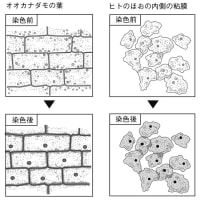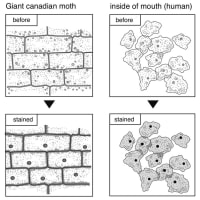
【目的】
植物と動物の細胞のつくりを顕微鏡で観察して、共通点と相違点を見つける。
【Goal】
Observe the cells of plants and animals with microscope to find similar or different points.
【準備物】
顕微鏡
スライドガラス
カバーガラス
ピンセット
柄つき針
ろ紙
カッターナイフ
ピペット・スポイト
タマネギ(ムラサキツユクサの葉)
オオカナダモ
酢酸オルセイン溶液(酢酸カーミン溶液 または 酢酸ダーリア溶液)
綿棒
必要であれば保護メガネ
【Preparation】
Microscope
microscope slide
cover glass
tweezers
needle with a handle
filter paper
box cutter kife
pipette
Onion, a leaf of Purple dayflower
some leaves of Giant canadian moth
Orcein acetate (Carmain acetate or Dahlia acetate)
cotton swab
safety glasses (if necessary)
【方法】
A 植物の細胞の観察
タマネギの薄皮の観察についてはこちら↓
① タマネギの薄皮にカッターナイフで5mm四方の切り込みを入れ、ピンセットで薄皮をはぎ取る。
② 切り取った薄皮をスライドガラスの上に置き、ピペットで酢酸オルセイン溶液を一滴垂らす。
③ オオカナダモの若い葉を切り取ってスライドガラスの上に乗せ、スポイトで水を一滴垂らす。
同じように別のオオカナダモの葉を切り取り、スライドガラスの上に乗せ、ピペットで酢酸オルセイン溶液を一滴垂らす。
④ 5分置いたあと、柄つき針で支えながら、ピンセットで薄皮(またはオオカナダモ)の上にカバーガラスを静かに下ろし、プレパラートを作る。
⑤ 100倍程度の低倍率で観察したあと、400〜600倍の高倍率で観察する。



【Process】
A : Plant cells
Cells of Onion↓
① Cut the skin of onion (inside) as 5mm square and pick the skin up with tweezers.
② Put the piece of skin on microscope slide and put a drop of Orcein acetate on it with a pipette.
③ Cut and put a leaf of Giant canadian moth on microscope slide and put a drop of water on it with a pipette.
In the same way, put another leaf on microscope slide and put a drop of Orcein acetate on it.
④ 5minutes later, while supporting a cover glass with a needle with a handle, match the edge of it and the edge of the water (or liquid).
Lower the cover glass on the skin of Onion (or a leaf) with tweezers to prevent air from entering (preparation).
⑤ Observe with lower magnification (×100), later higher magnification (×400~600).
B 動物の細胞の観察
① 口をよくゆすいだ後、綿棒でほおの内側を2〜3回こする。
② こすったものをスライドガラスにつける。
③ ピペットで酢酸オルセイン溶液を1滴垂らす。
④ 5分置いたあと、柄つき針で支えながら、ピンセットでその上にカバーガラスを静かに下ろし、プレパラートを作る。
⑤ 100倍程度の低倍率で観察したあと、400〜600倍の高倍率で観察する。
B : Animal cells
① After rinsing the mouth well, rub the inside of the cheek 2-3 times with a cotton swab.
② Put the rubbed material on a microscope slide.
③ Put a drop of Orcein acetate on it.
④ 5minutes later, while supporting a cover glass with a needle with a handle, match the edge of it and the edge of the liquid.
Lower the cover glass on it with tweezers to prevent air from entering (preparation).
⑤ Observe with lower magnification (×100), later higher magnification (×400~600).
【結果】
植物の細胞(オオカナダモ)には、緑の丸い構造物が多数見られる。
植物の細胞も動物の細胞も、酢酸オルセイン溶液でよく染まる丸い構造物が1つずつ見られる。
植物の細胞は四角いものが多いが、動物の細胞は丸いか、不定形のものが多い。
【Results】
Plant cells (giant Canada spiders) show many green round structures.
Both plant and animal cells show one round structure that is well stained with Orcein acetate.
Plant cells are often square, while animal cells are often round or irregularly shaped.


【考察】
植物と動物の細胞には核を1つずつもつという共通点がある。
植物の葉の細胞には、葉緑体が見られる。
植物の細胞には細胞壁があって四角いので、骨がなくても大きなからだを持つことができる。
動物の細胞は細胞壁がないので不定形をしている。
【Study】
Plant and animal cells have a nucleus in common.
Chloroplasts are found in leaf cells of plants.
Plant cells have cell walls that are square, allowing them to have large bodies without bones.
Animal cells have no cell walls and are irregularly shaped.




















※コメント投稿者のブログIDはブログ作成者のみに通知されます